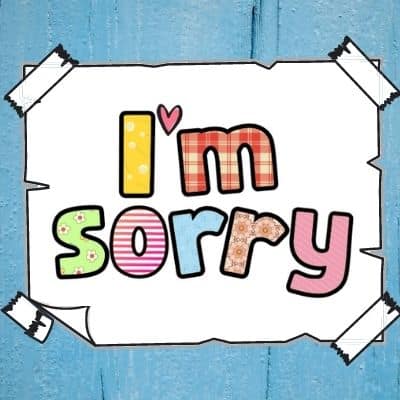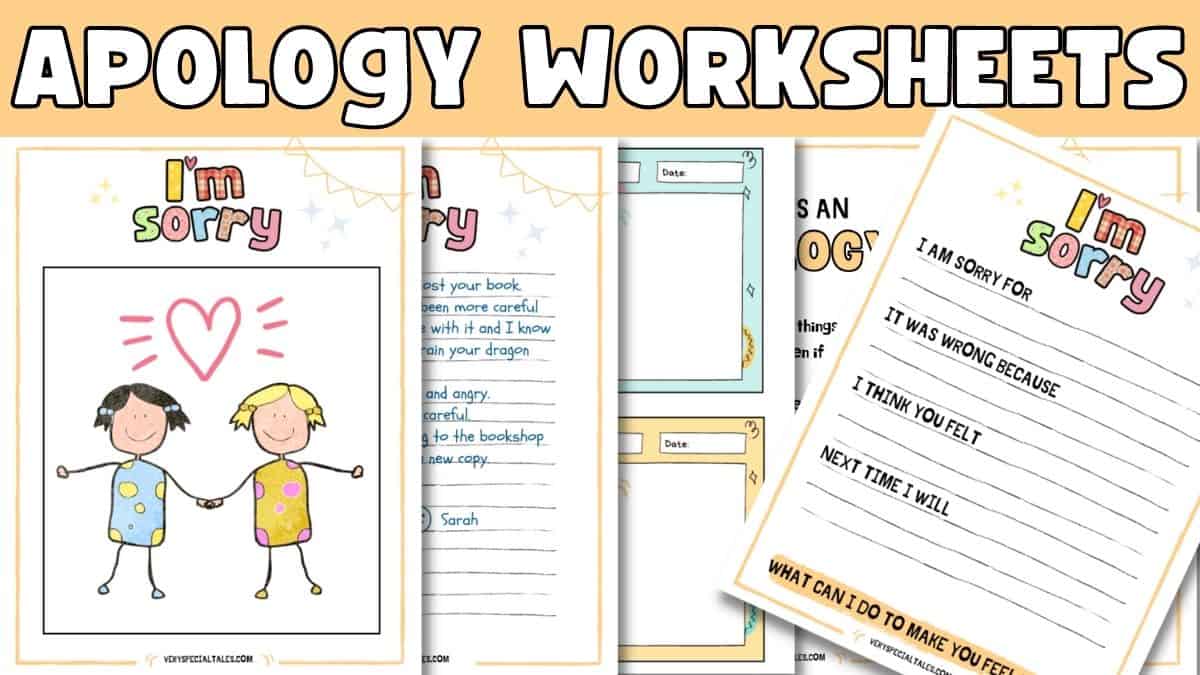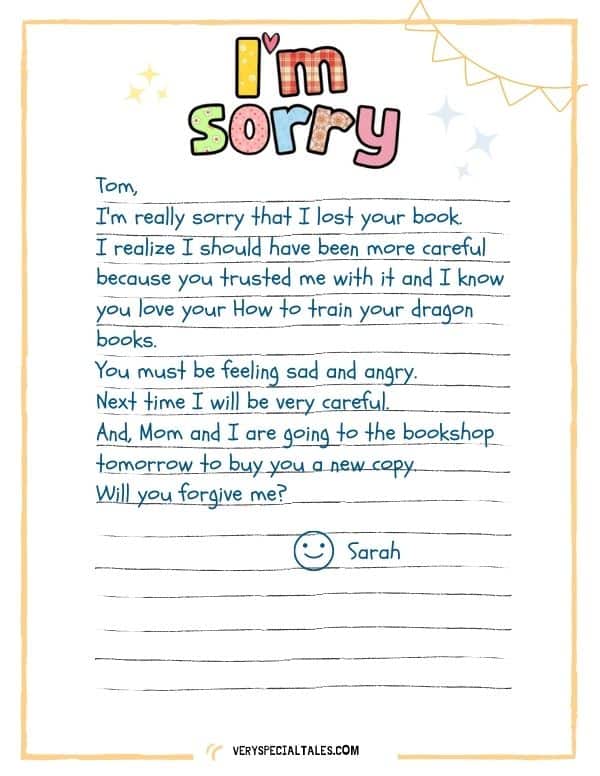
Learning to Say Sorry: Activities and Worksheets (Printable PDF)

7 Fun “Say Sorry” Activities to Teach Kids How to Apologize
In this post, we will learn how to say sorry, what makes a good apology (and apologies that aren’t apologies), and we will suggest fun “say sorry activities” for kids. You will be able to download your apology worksheets (printable PDF) that include apology letters’ and cards’ templates.
Teaching kids how to apologize is a valuable tool that they will be able to use when appropriate.
The concept of an apology is essentially one person acknowledging that an action was wrong and hurtful. While people of all ages could use a lesson in saying ‘I am sorry,’ teaching kids to apologize is an important skill to instill.
No matter what children are apologizing for, if they hurt someone, then saying sorry is an important step.
This article covers everything that goes into what makes a valuable apology and how to educate children on saying those three kind words:I am sorry.
Why Should We Teach Our Kids to Say Sorry
There are many reasons why this is so important:
- It’s a valuable social gesture
- Saying sorry helps children identify their mistakes
- Apologizing means they take responsibility for their actions
- It teaches the power of healing a relationship
- It helps heal any negative feelings
- It helps them feel better about themselves (we have fixed a wrong-doing)
Since everyone makes mistakes, learning to apologize is an essential part of growing up.
Whether they pull the head off of their sister’s favorite doll, say some unkind words to a friend, or act out violently from anger, there will come a time when will need to say “I’m sorry”.
Why do Kids Find it Difficult to Apologize?
There are several reasons why kids may find it difficult to apologize:
- Lack of understanding.
Some kids may not understand what they did was wrong. - Feeling ashamed or embarrassed.
Apologizing implies admitting to another person that we did something wrong.
Finding the courage to apologize can be very challenging for anyone, but it’s even more difficult for little ones just finding their way in the world.
When kids act in a way that requires an apology, it is usually rooted in a big emotion. Oftentimes, this is the first time young kids are experiencing a heightened sense of a feeling and they react incorrectly.
For example:
Timmy hit Johnny because Johnny wouldn’t share his toy.
Timmy needs to apologize, but that requires him to understand how wrong he was and admit that to his peers.
That can be scary!
It is important to understand that these big emotions can play a significant role in teaching kids how to apologize. In fact, it is key for helping them identify their emotions for any future triggers.

What Makes a Good Apology?
There are six parts to a good apology that kids should learn to try and incorporate into their apologies
- Say ‘I am sorry for …’ / “I apologize for…”
This is a key step to a good apology because we need to identify the action for which we feel remorse - Acknowledge that the behavior was wrong
- State how you understand how the behavior was hurtful to the other person
This is another key step because you acknowledge how your actions affected another person. - Listen to the other person
- Make amends
There are many ways to repair what you did: sometimes a hug or an apology card will be enough. Other times you may need to replace what was broken or offer another type of compensation. - Promise to do better and not do the behavior again
While these steps can take a few times to instill, there is a lot of value in teaching the children in your life what makes a good apology.
Luckily, there are other ways to teach kids how to apologize than waiting for bad decisions to be made (we will explore some fun “say sorry activities” at the end of this post)
What Makes a Bad Apology?
You kid may feel that just by saying “I’m sorry” they’ve ticked the apology box.
But, there are some things that show that what we are saying is not a true apology.
These are some things we must not do when we are apologizing and we really mean it:
- Don’t use the word “but”
Kids often struggle with this one. Does the following sentence sound like an apology?
“I’m sorry but you said something that made me mad”
Once you add the word “but” you are shifting the blame and you are not taking ownership of your actions. - Focusing on what the other person did.
We have to focus on our own actions. - Frustrated or annoyed body language, tone of voice, or facial expression
If your child shouts to their sibling “Ok, Ok! I said I’m sorry!”, that definitely doesn’t sound like a true apology.
A sincere apology requires more than your words, it is also conveyed with your body language and your tone of voice. - Getting mad if our apology is not accepted right away.
Sometimes, our apologies fix whatever has happened on the spot.
But some other times, the other person still feels hurt and needs some space and time before they are ready to forgive us.
Should we Force a Kid to Apologize?
When it comes to forcing your children to apologize, it probably won’t solve anything.
According to Joan Durrant, a developmental psychologist and author of Positive Discipline in Everyday Parenting, forcing kids to apologize is essentially training them to lie.
Think about your own mistakes.
If someone forced you to apologize, would you want to?
Children are the same way.
Instead of forcing children to apologize, start from a place of curiosity. When something happens that warrants an apology, ask open-ended questions to help them come to a conclusion on their own.
Aim for questions that will help children become aware of the feelings of everyone involved. For example, start with “what were you feeling when you did XYZ?” to help them identify their emotions so that you can explain that emotion does not justify how they reacted.
This technique will (hopefully) lead them to decide to apologize on their own.
7 Fun Activities to Practice Apologizing
There are many different ways to practice apologizing safely and entertainingly.
These “Say Sorry” Activities will provide kids with opportunities to apologize and will help them build this important social skill:
1. Apology Role-Play
Role-playing is a great tool to learn skills in a safe environment.
For this apology role-play, have one child pretend to do something that would hurt the other child. Then, ask them to role-play an apology.
Some examples of apology role-play scenarios:
-
- Sam colors over Tiffany’s picture
- Sarah smashes Peter’s sandcastle in the sandbox
- Tim lost Annie’s favorite book
2. Guess Fake or Real Apology
Play a guessing game where they need to figure out if an apology is real or fake.
Sit with the kids and present different scenarios where an apology is necessary. Have them come up with various real and fake apologies.
Then, go in a circle and have them read their apologies for lots of laughs. Each time a kid reads an apology, the others need to guess if it was real or not, and what gave them the clues.
An example of a fake apology could look like: ‘I am sorry you didn’t look where you were walking so I tripped you’ while a genuine apology sounds like ‘I’m sorry I tripped you, are you okay?’
⇒ You can use the tips from the good and bad apology section here.
3. Apology Books
Finding an age-appropriate book on apologizing is the perfect way to introduce the concept of apologies in a calm environment.
Then, once the time comes for them to apologize, they already have a strong foundation for it.
For younger kids, these picture books about sincere apologies are great reads:
-
- How to Apologize. It is the perfect combination of helpful advice on saying sorry and silliness to keep the kids’ attention.
- Sorry (Really Sorry). A cute and funny story that shows how our moods affect others and the value of a sincere apology
4. Write an Apology Letter
An apology letter allows your kid to put their feelings in writing when they are on their own.
They can reflect on their actions and how they affect others.
An apology letter is a nice exercise for those kids who are struggling to make a face-to-face apology.
And, it will probably help them improve this skill and find the courage to apologize using their words in the future.
Two ideas for your kid’s apology letters practice:
- Make up scenarios with your kids for an imaginary character and have them work on an apology letter to that character.
- Ask your kid to think about a time when they did something that required an apology, and write a letter apologizing about their actions.
Keep in mind that the goal is to teach kids how to apologize, so focus on the six steps in a successful apology mentioned earlier.
5. Apology Worksheets
Worksheets are always helpful tools to learn and practice new concepts. An apology worksheet will take your kids through the basic steps that make a good apology.
I’ve included an apology worksheet PDF download with all the prompts that make a good apology at the end of the post:
- I’m sorry for… (show remorse)
- It was wrong because …(acknowledge it was wrong)
- I know you felt …(acknowledge how it affected the other person)
- Is there anything I can do to make you feel better? (Make amends)
6. Make an Apology Drawing
If your child is too young or just loves drawing, an apology drawing is a creative and beautiful way to say you are sorry and make amends with the person your wronged.
7. Prepare an Apology Card
An apology card is an alternative to an apology letter.
It is a way to show you care and it helps you repair what you did.
It can be as simple as a line saying “I’m sorry” or as creative as a drawing.
This last point is not an activity, but I feel is a very valuable tip to teach your kids how to apologize:
Be a good role model: Model Apologizing
Take the opportunity when the kids are around to model apologizing. It can be at the dinner table, and you apologize to your partner or with the grocery store clerk for the jar of peanuts you accidentally dropped.
Allowing kids to see that even adults need to apologize from time to time can help them say sorry easily when the time comes.
Other Social Skills Resources
- I-Statement Worksheets
- Conflict Resolution Activities for Kids
- Self-Introduction for Kids (Worksheets)
- Social Skills Activities for Kids
- Conversation Starters for Kids
- Listening Games and Activities
Apology Worksheets (Printable PDF) Download
Download your printable apology worksheets that include:
- What is an apology (a definition for kids)
- I’m Sorry Worksheet
- Apology letter template
- Apology cards
Did you remember to save a pin?⇓


One Comment
-
Amélie Very cool











